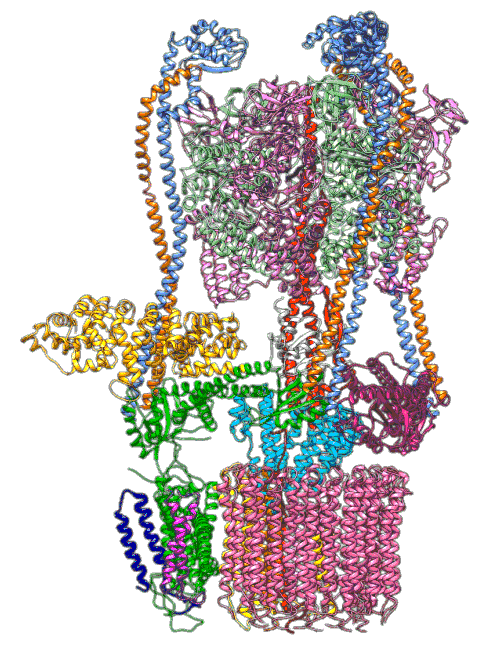Uncovering details of molecular Ferris wheels inside cell structures
Using the Summit supercomputer at the US Department of Energy's Oak Ridge National Laboratory, a team at the Arizona State University Biodesign Institute has confirmed details of a molecular mechanism that cell organelles use to regulate the pH of their environment — and it looks a lot like a Ferris wheel.
Led by Abhishek Singharoy, a researcher at the Biodesign Center for Applied Structural Discovery (CASD) and Arizona State University's School of Molecular Sciences (SMS), the team used Summit to simulate molecular pumps that are embedded in the fatty outer membranes of cellular organelles, or cell structures that are specialized to perform different tasks for the cell's functioning. With rotors that spin 100 times per second, these pumps rapidly move protons — positively charged subatomic particles — into a cell's organelles to maintain the acidic environment inside that is crucial to the work they perform.
Using the nation's fastest supercomputer — the Oak Ridge Leadership Computing Facility's (OLCF's) Summit — the team uncovered a key step in how this mechanism works in one proton pump in particular, a yeast proton pump called vacuolar ATPase (V-ATPase) that is necessary for a variety of tasks in the body and has implications in disease. The results were published in Science Advances.

"The V-ATPase proton pumps perform a wide range of functions, from helping transmit nerve signals to helping specialized cells secrete acid for maintaining bone," said Stephan Wilkens, a biochemist at SUNY Upstate Medical University and study co-author. "Malfunctions in these molecular machines contribute to diseases such as osteoporosis, neurodegeneration, diabetes, cancer, and AIDS, so understanding them is important for human health."
A team led by Wah Chiu—professor at the SLAC National Accelerator Facility and Stanford University and codirector of the Stanford-SLAC Cryo-EM Facilities—together with Wilkens and SLAC/Stanford postdoctoral researcher Soung-Hun Roh, had already performed work at SLAC that employed Cryogenic electron microscopy (cryo-EM) to study these proton pumps. Images from the work showed 10 amino acid "seats" on a molecular Ferris wheel that bind protons and carry them through the membrane to the organelle's interior, as well as other amino acids that catch them when they arrive. Based on that picture, the team working on the research suggested that the proton drop-off might be aided by water molecules—but their images were not sharp enough to confirm that the water molecules were there. In the same study, another round of even higher resolution cryo-EM images showed the water molecules around the suspected proton path.
Singharoy and his team used the Nanoscale Molecular Dynamics, or NAMD, code to perform simulations on the Summit supercomputer and confirmed that the experimentally observed water molecules line up to form "wires" at the proton drop-off point. These wires convey protons from their seats on the Ferris wheel to landing spots inside the organelle, like a fire brigade passing buckets hand to hand, bridging a gap they couldn't navigate on their own. The work was performed under the Innovative and Novel Computational Impact on Theory and Experiment, or INCITE, program at the OLCF.
The simulations matched the cryo-EM images nicely, providing strong evidence that the picture they painted of the proton drop-off is correct.
"Molecular motors exemplify some of the most intricate chemo-mechanical devices, and our team in SMS and CASD has developed highly sophisticated computational tools to address the energy source and sinks of the motor's ratcheting motion," Singharoy said. "In 2017 we started working on the soluble part of the V-type motor, namely, V1 ATPase. Now that we have a good control on the transmembrane Vo motor, it's a great step forward toward simulating the entire motor in collaboration with Hun, Stephan, and Wah."
Chiu said that recent advances in cryo-EM that allow imaging of individual particles at atomic resolution—even when they take slightly different shapes—will open new opportunities for using it as a tool to discover effective drugs for illnesses involving proton pumps.
Enjoy reading ASBMB Today?
Become a member to receive the print edition four times a year and the digital edition monthly.
Learn moreGet the latest from ASBMB Today
Enter your email address, and we’ll send you a weekly email with recent articles, interviews and more.
Latest in Science
Science highlights or most popular articles

Exploring the link between lipids and longevity
Meng Wang will present her work on metabolism and aging at the ASBMB Annual Meeting, March 7-10, just outside of Washington, D.C.

Defining a ‘crucial gatekeeper’ of lipid metabolism
George Carman receives the Herbert Tabor Research Award at the ASBMB Annual Meeting, March 7–10, just outside of Washington, D.C.

The science of staying strong
Muscles power every movement, but they also tell the story of aging itself. Scientists are uncovering how strength fades, why some species resist it and what lifestyle and molecular clues could help preserve muscle health for life.

Bacteriophage protein could make queso fresco safer
Researchers characterized the structure and function of PlyP100, a bacteriophage protein that shows promise as a food-safe antimicrobial for preventing Listeria monocytogenes growth in fresh cheeses.

Building the blueprint to block HIV
Wesley Sundquist will present his work on the HIV capsid and revolutionary drug, Lenacapavir, at the ASBMB Annual Meeting, March 7–10, in Maryland.

Gut microbes hijack cancer pathway in high-fat diets
Researchers at the Feinstein Institutes for Medical Research found that a high-fat diet increases ammonia-producing bacteria in the gut microbiome of mice, which in turn disrupts TGF-β signaling and promotes colorectal cancer.

